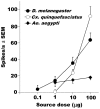Generic insect repellent detector from the fruit fly Drosophila melanogaster
- PMID: 21436880
- PMCID: PMC3059203
- DOI: 10.1371/journal.pone.0017705
Generic insect repellent detector from the fruit fly Drosophila melanogaster
Abstract
Background: Insect repellents are prophylactic tools against a number of vector-borne diseases. There is growing demand for repellents outperforming DEET in cost and safety, but with the current technologies R&D of a new product takes almost 10 years, with a prohibitive cost of $30 million dollar in part due to the demand for large-scale synthesis of thousands of test compounds of which only 1 may reach the market. R&D could be expedited and cost dramatically reduced with a molecular/physiological target to streamline putative repellents for final efficacy and toxicological tests.
Methodology: Using olfactory-based choice assay we show here that the fruit fly is repelled by not only DEET, but also IR3535 and picaridin thus suggesting they might have "generic repellent detector(s)," which may be of practical applications in new repellent screenings. We performed single unit recordings from all olfactory sensilla in the antennae and maxillary palps. Although the ab3A neuron in the wild type flies responded to picaridin, it was unresponsive to DEET and IR3535. By contrast, a neuron housed in the palp basiconic sensilla pb1 responded to DEET, IR3535, and picaridin, with apparent sensitivity higher than that of the DEET detectors in the mosquitoes Culex quinquefasciatus and Aedes aegypti. DmOr42a was transplanted from pb1 to the "empty neuron" and showed to be sensitive to the three insect repellents.
Conclusions: For the first time we have demonstrated that the fruit fly avoids not only DEET but also IR3535 and picaridin, and identified an olfactory receptor neuron (ORN), which is sensitive to these three major insect repellents. We have also identified the insect repellent-sensitive receptor, DmOr42a. This generic detector fulfils the requirements for a simplified bioassay for early screening of test insect repellents.
Conflict of interest statement
Figures










Similar articles
-
Neurophysiological and behavioral responses of gypsy moth larvae to insect repellents: DEET, IR3535, and picaridin.PLoS One. 2014 Jun 23;9(6):e99924. doi: 10.1371/journal.pone.0099924. eCollection 2014. PLoS One. 2014. PMID: 24955823 Free PMC article.
-
Insecticidal and Behavioral Avoidance Responses of Anopheles minimus and Culex quinquefasciatus (Diptera: Culicidae) to Three Synthetic Repellents.J Med Entomol. 2017 Sep 1;54(5):1312-1322. doi: 10.1093/jme/tjx081. J Med Entomol. 2017. PMID: 28419272
-
Insect repellents mediate species-specific olfactory behaviours in mosquitoes.Malar J. 2020 Mar 30;19(1):127. doi: 10.1186/s12936-020-03206-8. Malar J. 2020. PMID: 32228701 Free PMC article.
-
Trends in insect repellent formulations: A review.Int J Pharm. 2018 Mar 25;539(1-2):190-209. doi: 10.1016/j.ijpharm.2018.01.046. Epub 2018 Feb 3. Int J Pharm. 2018. PMID: 29410208 Review.
-
Mosquito repellents for the traveller: does picaridin provide longer protection than DEET?J Travel Med. 2018 May 1;25(suppl_1):S10-S15. doi: 10.1093/jtm/tay005. J Travel Med. 2018. PMID: 29718433
Cited by
-
Spatial Repellency Caused by Volatile Pyrethroids is Olfactory-Mediated in the German Cockroach Blattella germanica (Dictyoptera: Blattellidae).Neotrop Entomol. 2020 Apr;49(2):275-283. doi: 10.1007/s13744-019-00739-9. Epub 2019 Dec 9. Neotrop Entomol. 2020. PMID: 31820337
-
Neuroethology of Olfactory-Guided Behavior and Its Potential Application in the Control of Harmful Insects.Front Physiol. 2016 Jun 30;7:271. doi: 10.3389/fphys.2016.00271. eCollection 2016. Front Physiol. 2016. PMID: 27445858 Free PMC article. Review.
-
Drosophila melanogaster Chemosensory Pathways as Potential Targets to Curb the Insect Menace.Insects. 2022 Jan 28;13(2):142. doi: 10.3390/insects13020142. Insects. 2022. PMID: 35206716 Free PMC article. Review.
-
The mysterious multi-modal repellency of DEET.Fly (Austin). 2015;9(1):45-51. doi: 10.1080/19336934.2015.1079360. Fly (Austin). 2015. PMID: 26252744 Free PMC article. Review.
-
Comparison of research methods for functional characterization of insect olfactory receptors.Sci Rep. 2016 Sep 16;6:32806. doi: 10.1038/srep32806. Sci Rep. 2016. PMID: 27633402 Free PMC article.
References
-
- Anonymous The impact of malaria, a leading cause of death worldwide. 2004. http://wwwcdcgov/malaria/impact/indexhtm.
-
- Leal WS. Behavioural neurobiology: The treacherous scent of a human. Nature. 2010;464:37–38. - PubMed
-
- Gubler DJ. Dengue and dengue hemorrhagic fever: its history and resurgence as a global health problem. In: Gubler DJ, Kuno G, editors. Dengue and dengue hemorrhagic fever. New York: CAB International; 1997. pp. 1–22.
-
- Nasci RS, Miller BR. Culicine mosquitoes and the agents they transmit. In: Beaty BJ, Marquardt WC, editors. The biology of disease vectors. Niwot: University Press of Colorado; 1996. pp. 85–97.
-
- Faulde MK, Albiez G, Nehring O. Insecticidal, acaricidal and repellent effects of DEET- and IR3535-impregnated bed nets using a novel long-lasting polymer-coating technique. Parasitol Res. 2010;106:957–965. - PubMed
Publication types
MeSH terms
Substances
LinkOut - more resources
Full Text Sources
Other Literature Sources
Molecular Biology Databases
Miscellaneous

